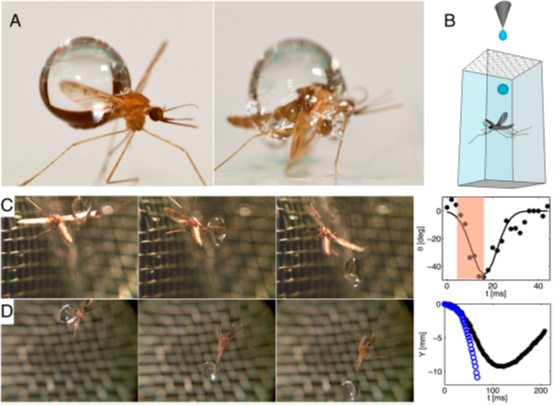Mosquitoes thrive in areas of high humidity and rainfall, in which raindrops can weigh more than 50 times a mosquito. Free-flying mosquitoes can survive the high-speed impact of falling raindrops. High-speed videography of those impacts reveals a mechanism for survival: A mosquito's strong exoskeleton and low mass renders it impervious to falling drops. The mosquito's low mass causes raindrops to lose little momentum upon impact and so impart correspondingly low forces to the mosquitoes.
The raindrop impact experiments on both mosquitoes and their mimics, finding that the momentum and force imparted to the insect is determined entirely by the insect's mass relative to the drop. The mosquito is so lightweight that the resulting force imparted upon it is low, enabling a mosquito to survive flying in the rain.
Although the raindrop force imparted to a mosquitoes is low, the mosquito’s low mass causes the concomitant acceleration to be quite high. Insects struck by rain may achieve the highest survivable accelerations (100–300 g) in the animal kingdom. In comparison, the current champions of generating acceleration are fleas, which experience 135 g when jumping. The similarity between these maximal accelerations may suggest a fundamental limit to survival among organisms.
Mosquitoes may experience life-threatening impacts if flying very low to the ground. Without sufficient distance to recover from impact, the insect could strike the ground with the speed of a falling drop or be immersed in pools of water from which it cannot escape. A mosquito which landed into a puddle ultimately perished, not from the impact of drops, but by drowning due to adhesion of its body with the water surface. Although the insect is covered in water-repellent hairs, these hairs do not seem to confer any advantage with respect to the force imparted. The hydrophobicity, however, may be advantageous in enabling the insect to separate from the drop as is necessary for recovery postimpact. The hairs may also be advantageous in surviving puddles.

(A) Impact of a 3-mm drop on a mosquito supported from below, meant to show the relative size of raindrop to a mosquito. (B) Schematic of our drop impact chamber. (C) Time sequence of a mosquito spun by a falling drop. Graph shows the time course of angular position of a mosquito where the pink shaded area denotes the duration of contact with the drop. (D) Time sequence of a mosquito pushed by a drop. Graph shows the time courses of vertical positions of the mosquito (black) and drop (blue). In both impacts (C and D), the mosquito easily recovers and continues flying.
Information Source: https://www.pnas.org/content/pnas/109/25/9822.full.pdf

